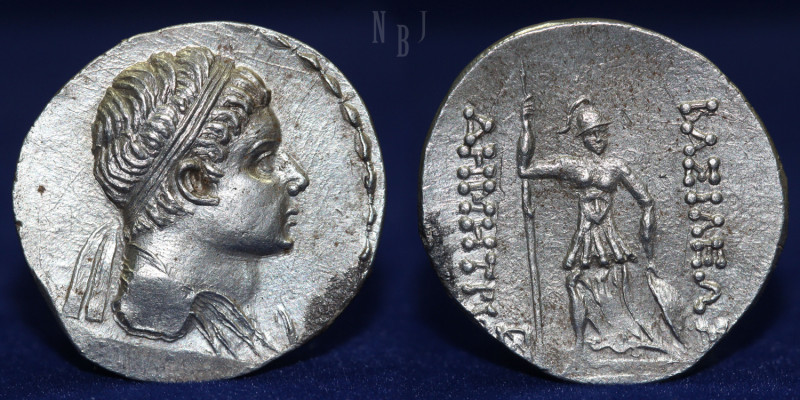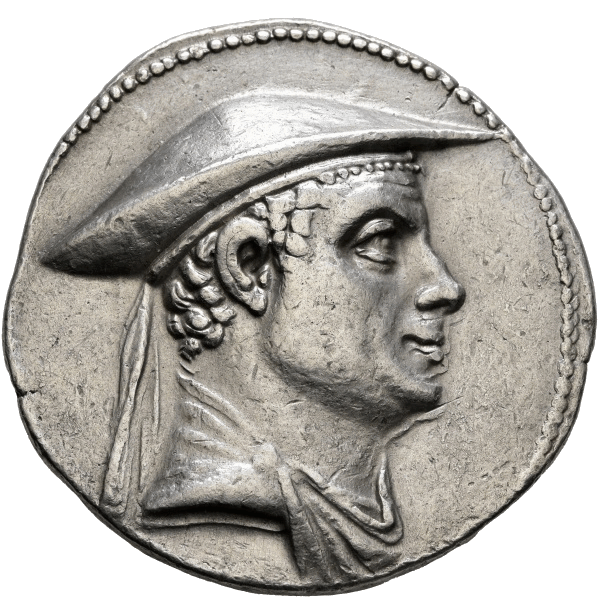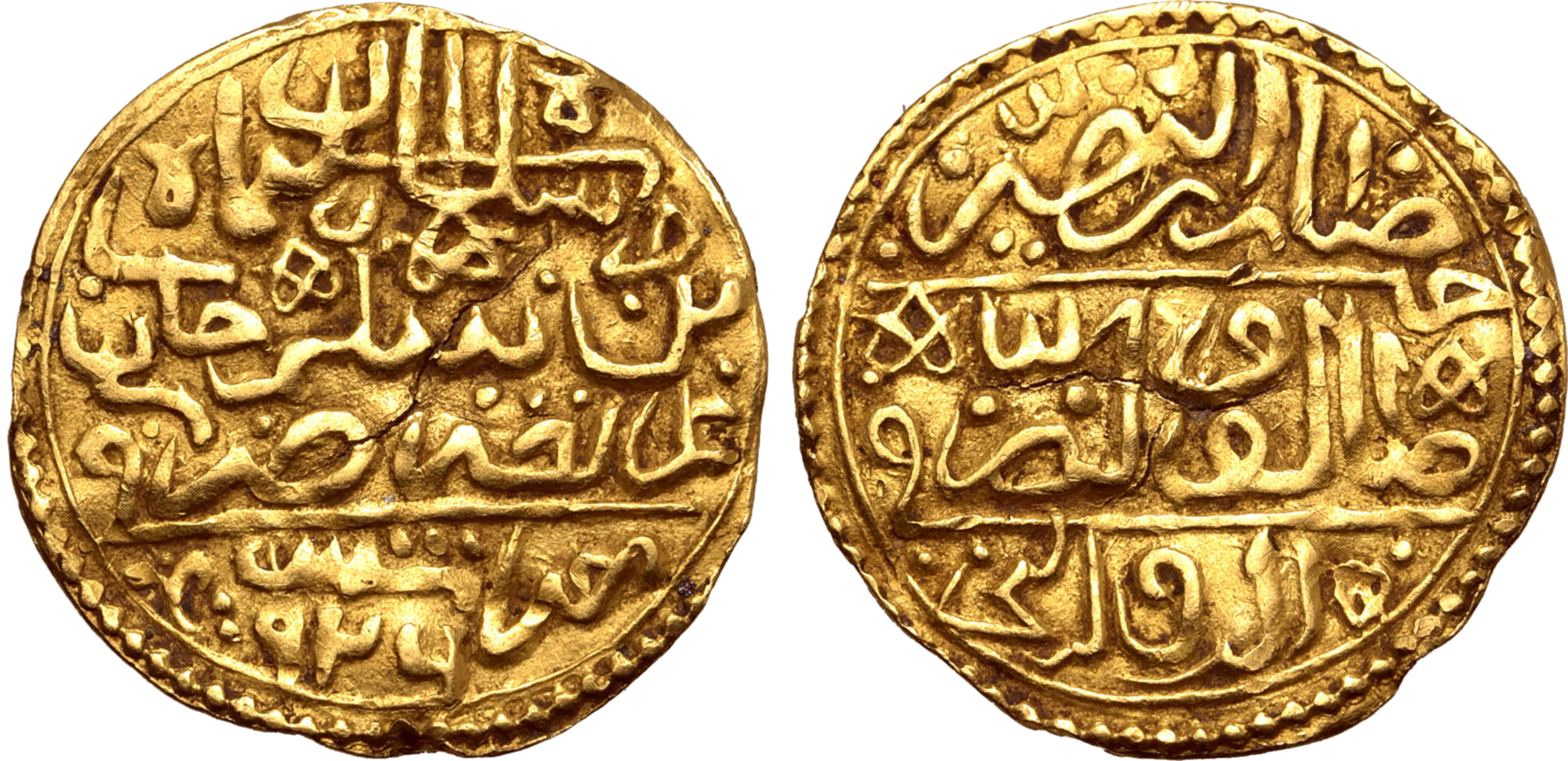-
Posts
215 -
Joined
-
Last visited
Content Type
Profiles
Forums
The Numis Journal
Events
Downloads
Gallery
Store
Classifieds
Posts posted by Cordoba
-
-
3 hours ago, Prieure de Sion said:
I love these coins from Bactria - they have a very special style. Fantastic. Unfortunately, I have zero knowledge in this area.
Agreed, I think greco-bactrians have some of the best style out there. Unfortunately that is part of why it's typically so expensive. There is a lack of historical records on the history of the region, so it's interesting how much we have to piece together from numismatic evidence, for better or worse.
-
 2
2
-
-
With this, I now have a full set of menander's indic weight tets. this one seems to have traces of overstriking on the obverse.

BAKTRIA, Indo-Greek Kingdom. Menander I Soter. Circa 155-130 BC. AR Tetradrachm (24mm, 9.72 g, 12h). Diademed heroic bust left, seen from behind, wearing aegis and brandishing spear / Athena Alkidemos advancing left; monogram to inner right. Bopearachchi 8A; SNG ANS 745-6; HGC 12, 180
-
 14
14
-
 3
3
-
-
between heritage and triton, my wallet is not going to have fun. not as many bactrians as last year, but there are still quite compelling offerings. I'll definitely be bidding

-
 6
6
-
-
Datames stater with sloppy centering. luckily baaltars was unscathed


Satrap of Cilicia. Datames, 384-361/0 BC. Stater (Silver, 25 mm, 10.22 g, 9 h), Tarsos.
Obv: [𐡁𐡏𐡋𐡕𐡓𐡆] ('b'ltrs' in Aramaic) Baaltars seated right on throne, with torso facing, holding grain ear, grape bunch and eagle-tipped sceptre; below throne, forepart of a bull right; all within crenellated wall.
Rev: 𐡕𐡓𐡊𐡌𐡅 ('trkmw' in Aramaic) Datames seated right on throne, holding arrow; winged solar disk to upper right, [bow to lower right].
Reference: Casabonne Series 2; SNG Levante 87; SNG BN 289.
next: cilician stater
-
 10
10
-
 1
1
-
-
1 hour ago, robinjojo said:
This gold dinar came out of the Roma auction last July, Auction XXVIII, lot 419. This coin replaces one that I sold over 30 years ago. Given enough centuries, I do get around doing these things!
Kushan Empire, Vasudeva I, AV dinar, Balkh, Bactria, circa 190-230 AD.
MK 528 (O1a,R34, Vasudeva II)
8.12 grams
beautiful coin! we don't see enough kushans on here. you got it for a really good price too.
-
 5
5
-
-
For baktrian kings, demetrios II falls into this category. these are pretty rare, and usually not great style wise either. I'd expect to have to pay $3k plus for a decent example. I missed out twice on ones that went cheaply, and i regret not going for it back then. this will probably be a hole in my collection for a long while, since there are other priorities i'd like to focus on (agathokles, antimachos, heroic eukratides), which are all nicer style wise, which is what i'm starting to focus on now.

-
 10
10
-
-

I bought two antimachos tetradrachms with the same monogram. I bought the first, and the second went really cheaply at leu. I had put in a bid and did not expect to win. still pretty happy with both, and they turned out to be an obverse die match.
Obv: Diademed and draped bust of Antimachos I to right, wearing flat topped kausia.
Rev: Poseidon, nude to the waist, standing facing, holding long trident in his right
hand and filleted palm branch in his left; in inner right field, monogram-
 11
11
-
 1
1
-
-
I had bought a eukratides tetradrachm from roma a year ago, and it had a case of horn silver. It had progressively darkened, and got quite distracting, so I tried out sodium thiosulfate on it. It worked quite well, especially on the obverse. I have to thank Roerbakmix and his thread on cointalk detailing the process. The process was pretty simple, and I wasn't exactly scientific in measuring. I heated up distilled water, and made a solution of roughly 95% water to 5% sodium thiosulfate. The sodium thiosulfate would cause the horn silver to darken, and would come off afterwards in water. Below is the progression of the coin and then the after photos from cleaning.
Feel free to post any coins you've had luck cleaning, or bactrians 🙂
Several months after purchase

Right before cleaning

After cleaning

-
 13
13
-
 3
3
-
-
Great win, congrats!
Seeing as the Andragoras-Sophytes hoard is drying up, i picked up a bactrian owl. was tempted to go a bit harder on the other bactrians, but seems more prudent to wait for january.
 Baktria, 'Athenian Series' AR Tetradrachm. Uncertain mint in the Oxus region, circa 261-238 BC. Attic standard. Head of Athena to right, wearing earring, necklace, and crested Attic helmet decorated with three olive leaves over visor and a spiral palmette and grape bunch(?) on the bowl / Owl standing to right, head facing; olive sprig and crescent behind, AΘE before; all within incuse square. Roma E-98, 585 var. (obv. legend); Bopearachchi, Sophytes -; Mitchiner -; SNG ANS -. 16.73g, 24mm, 12h.
Baktria, 'Athenian Series' AR Tetradrachm. Uncertain mint in the Oxus region, circa 261-238 BC. Attic standard. Head of Athena to right, wearing earring, necklace, and crested Attic helmet decorated with three olive leaves over visor and a spiral palmette and grape bunch(?) on the bowl / Owl standing to right, head facing; olive sprig and crescent behind, AΘE before; all within incuse square. Roma E-98, 585 var. (obv. legend); Bopearachchi, Sophytes -; Mitchiner -; SNG ANS -. 16.73g, 24mm, 12h.
-
 8
8
-
-
Decided it was time to finally get a menander tetradrachm, seeing that CNG seems to be dispersing a hoard of these guys.

BAKTRIA, Indo-Greek Kingdom. Menander I Soter. Circa 155-130 BC. AR Tetradrachm (26mm, 9.58 g, 12h). Diademed and draped bust right, wearing crested helmet adorned with pelt and wing / Athena Alkidemos advancing left; Σ and monogram flanking. Bopearachchi 15B
-
 17
17
-
 2
2
-
 2
2
-
-
venturing into medieval, but I'm pretty fond of this red patina on this coin.

Artuqids of Mardin. Nasir al-Din Artuq Arslan, AD 1201-1239. Dirham
(Bronze, 29 mm, g, 10 h), MardinObv: Male figure sitting cross-legged on throne, holding small globe.
Rev: Kufic inscription, citing the Ayyubid ruler al-Kamil Muhammad
as overlord.
Reference: Spengler & Sayles 46; Album 1830.9.-
 14
14
-
-
pretty mediocre bactrian section, but that is the norm for roma nowadays
-
 1
1
-
-
-
I recently picked up a stater of Datames, and I'm super pleased with it. I'm also trying to research its provenance, and was wondering if anyone had a copy of the Auctiones 6, 1976 Catalog, Lot 263. I can't find it online or for sale currently, so was wondering if someone had a copy available.
I'm really happy to pick up this interesting type with nice toning. The Baaltars is quite crisp, and a lot more detailed than the Baaltars on my other Cilician staters. The reverse depicts a satrap, likely Datames, in satrapal regalia seated on a Persian-style throne. The depiction of the actual satrap is quite unusual in satrapal coinage. Such imagery may be an attempt to assert his legitimacy, which suggests that this issue was minted during the time of the Great Satraps' Revolt against Artaxerxes II. I've attached both my photos, and the auction house's photos below. I had a lot of trouble taking photos of this coin because of its dark toning.


Satrap of Cilicia. Datames, 384-361/0 BC. Stater (Silver, 25 mm, 10.22 g, 9 h), Tarsos.
Obv: [𐡁𐡏𐡋𐡕𐡓𐡆] Baaltars seated right on throne, with torso facing, holding grain ear, grape bunch and eagle-tipped sceptre; below throne, forepart of a bull right; all within crenellated wall.
Rev: 𐡕𐡓𐡊𐡌𐡅 Datames seated right on Persian-style throne, holding arrow; winged solar disk to upper right, bow to lower right.
Reference: Casabonne Series 2; SNG Levante 87; SNG BN 289.
Provenance: Ex Auctiones 6, 1976, 263. From the collection of a Mentor.If anyone is interested in Cilician staters, then I’d suggest reading Moysey’s The Silver Stater Issues of Pharnabazos and Datames from the Mint of Tarsus in Cilicia.
-
 14
14
-
 4
4
-
-
28 minutes ago, El Cazador said:
You clearly have no idea what you talking about
No need to be rude and spam post this thread, especially if you aren't going to contribute to it.
-
 1
1
-
-
here and the discord server. I used to browse r/AncientCoins more, but I found that there isn't much interesting discussion there. The interesting stuff is often already posted here or on discord anyways.
-
 3
3
-
-

Just picked up a new Mazaios Stater. The reverse is quite nice to me, and thought it was a decent price.
Satrap of Cilicia, 361/0-334 BC. AR Stater, (26 mm, 10.74 g, 10 h) Casabonne Series 2, Group A; SNG BN 339; SNG Levante 102.
-
 10
10
-
-
I've been meaning to pick up a pre-diodotid coin from baktria, but other priorities keep getting in the way. maybe someday i'll pick up a bactrian owl
I've posted a lot of my bactrians, but I don't think I've shown this one yet. I was quite happy to win this earlier this year, as this type is quite rare. This tetradrachm of Antimachos is likely an contemporary imitation. The portrait is a lot more goofy than the typical Antimachos portrait, with a much uglier rendering of his facial features. Although it uses a completely different mint mark than other antimachos tetradrachms, its stylistic similarities with contemporary imitations of Euthydemos and Eukratides suggest it is a contemporary imitation, and not the work of an official mint with inferior die engravers.

Greco-Baktrian Kingdom. Antimachos I, circa 180-165 BC. Tetradrachm
(Silver, 32 mm, 16.64 g, 12 h)Obv: Diademed and draped bust of Antimachos I to right, wearing flat topped kausia.
Rev: Poseidon, nude to the waist, standing facing, holding long trident in his right
hand and filleted palm branch in his left; in inner right field, monogram.
BΑΣΙΛΕΩΣ ΘΕΟΥ ΑΝΤΙΜΑΧΟΥ
Reference: Bopearachchi 1C; HGC 12, 106; MIG Type 124dComparision with typical antimachos tetradrachms

-
 13
13
-
-
seems like a hoard of these is being dispersed. I decided to get a couple, since prices were going down. looking to get an attambelos in the future too.

Kingdom of Characene. Hyspaosines, circa 127-124 BC. Tetradrachm (Silver, 32 mm, 16.43 g, 12 h), Charax-Spasinu. SE 186.
Obv: Diademed head of Hyspaosines to right.
Rev: ΒΑΣΙΛΕΩΣ - ΥΣΠΑΟΣΙΝΟΥ Herakles seated left, holding club set on his knee with his right hand and leaning left on rock draped with lion skin; to outer left, monogram; in exergue, ςΠΡ.
Reference: Alram 491

Greco-Baktrian Kingdom. Apodakos, 110-109 BC. Tetradrachm (Silver, 32.5 mm, 16.37 g, 12 h)
Obv: Diademed head of Apodakos to right.
Rev: ΒΑΣΙΛΕΩΣ ΑΠΟΔΑΚΟΥ / ΓΣ Herakles seated left on rock, holding club on knee; to outer left, monogram.
Reference: Alram 495.
-
 8
8
-
 1
1
-
-
i wouldn't have noticed either. it's a good reminder for me to do more due diligence, and makes me a bit nervous about my collection given that is a pretty convincing fake in my eyes
-
 1
1
-
-
is there a hoard of these dispersing? i think the recent leus have been selling a bunch of these, with pretty similar find patinas, from a european collection formed before 2005
-
 2
2
-
-
2 hours ago, Aleph said:
Anyone find it peculiar that 100% lots sold? That doesn’t happen without someone making sure every lot has a bid…
I watched live and i did see some lots go unsold haha, but their starting prices are generally pretty low
-
I collect a lot of Islamic coins, and here are a few types I find pretty interesting:
Turkoman Figural Bronzes - super cool designs, and fairly affordable

Artuqids of Mardin. Husam al-Din Timurtash, AD 1122-1152. Dirham
(Bronze, 29 mm, 12.21 g, 7 h), Mardin. Spengler & Sayles 26; Album 1826.3; ICV 1198 (this coin).
Zangids of Mosul. Sayf al-din Ghazi II, AD 1169-1180. Dirham
(Bronze, 32 mm, 15.56 g, 11 h), Mosul. Spengler & Sayles 61.1; Album 1861.2Ottoman Gold - a lot more affordable than greek or roman gold, which is a plus

Ottoman Empire. Sulayman I The Magnificent, AD 1520. Sultani
(Gold, 21 mm, 3.36 g, 1 h), Misr
Lastly, Ghaznavid multiple dirhams are some of the largest medieval silver you can find. Article that goes more in depth here: http://augustuscoins.com/ed/Samanid/Samanid.html

Ghaznavid Empire. Mahmud of Ghazni, AD 998-1030. Multiple Dirham
(Silver, 47 mm, 10.57 g, 4 h), Andaraba. AH 389-
 14
14
-
-
I think the distinction is that it was done long ago right after the coin was minted, as opposed to being smoothed in the modern day. I'd be more okay with buying a chased coin according to that definition, but not a smoothed coin.
-
 1
1
-









8.12g11-22-23.jpg.8153ae2df51201bbe8d7e38ca891cab1.jpg)

























CPK's Top 13 Coins of 2023 (Sorry, I just couldn't limit it to ten!)
in 2023 Top Coins of The Year
Posted
great list, and neat provenances. my favs were the akragas and lysimachos!